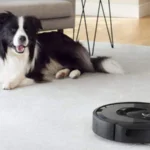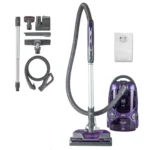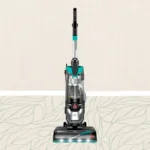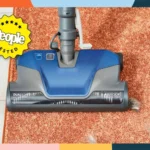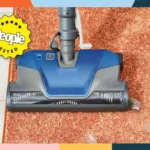As a pet owner with allergies, maintaining a clean and allergen-free home can be a daunting task. Every surface and piece of furniture seems to collect pet hair, dander, and urine, triggering allergy symptoms and making your home an uncomfortable place to be. However, with the advancements in technology, there is a solution that can help you breathe easier – smart vacuum cleaners. These cutting-edge devices come equipped with features that are specifically designed to address the challenges of pet ownership and allergies. In this article, we’ll explore how smart vacuums can benefit pet owners with allergies, what features to look for when choosing the right one, and which models are the best on the market.
What Are the Challenges for Pet Owners with Allergies?
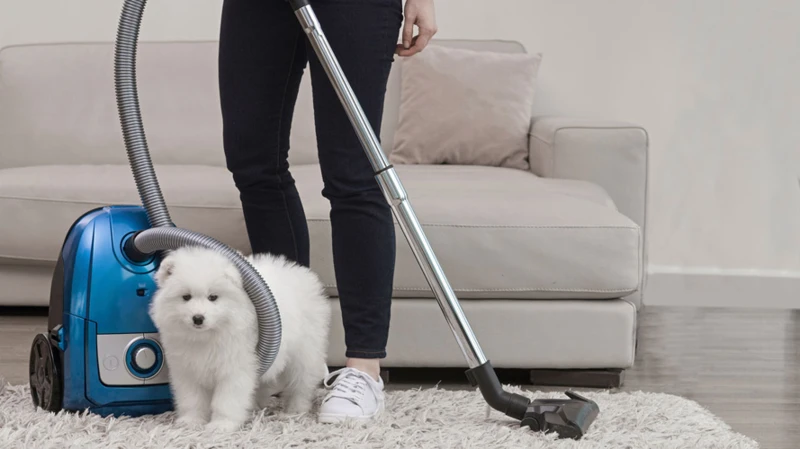
Being a pet owner can be a wonderful experience, but it can also be a challenge, especially when allergies are involved. For those who suffer from allergies, the challenges of owning a pet may seem overwhelming at times. Three of the most common allergens that pets produce are pet hair, pet dander, and pet urine. Let’s explore each of these challenges in more detail.
Pet Hair: Pet hair is one of the biggest challenges for pet owners with allergies. When pets shed, their fur gets everywhere, and it can be difficult to remove. Pet hair can accumulate on furniture, carpets, and clothing, making it nearly impossible to avoid. Not only is pet hair an irritant for those with allergies, but it can also be unsightly and difficult to clean up. To remove pet hair effectively, pet owners need a powerful vacuum cleaner with good suction power.
Pet Dander: Pet dander consists of microscopic skin flakes that pets shed naturally. These flakes can trigger an allergic reaction in people who are sensitive to them. Dander can also become airborne and circulate throughout the house, making it very difficult to avoid. To effectively remove pet dander from your home, you need a vacuum with a HEPA filter. A HEPA filter can capture particles as small as 0.3 microns, making it an essential feature for pet owners with allergies.
Pet Urine: Pet urine is another common allergen that pet owners have to deal with. When pets have accidents, the urine can soak into carpets and furniture, causing lingering odors and stains. In addition to being allergenic, pet urine can also be a breeding ground for bacteria and mold. To combat pet urine effectively, pet owners need a vacuum cleaner equipped with powerful suction and special cleaning tools.
While traditional vacuum cleaners can help with pet hair and pet dander, a smart vacuum cleaner offers additional benefits that can make life easier for pet owners with allergies. Let’s explore these benefits in more detail in the following section.
If you’re interested in learning more about the specific types of smart vacuum cleaners that are best for pet owners, check out our article on smart vacuum cleaners with HEPA filters for pet owners and our article on the top 5 smart vacuum cleaners for pet hair.
Pet Hair
Pets can bring so much joy and companionship into our lives, but for pet owners with allergies, they can also bring their fair share of challenges. One of the main culprits of allergies for pet owners is pet hair. Pet hair can be found in every nook and cranny of your home, and can be especially difficult to remove from carpets and furniture. Not only is it unsightly, but it can also trigger allergic reactions. In this section, we will discuss how smart vacuum cleaners can help pet owners overcome the problem of pet hair, and recommend some top models to consider. If you’re also interested in comparing different types of vacuums that are suitable for pet hair, check out our article on Roomba vs. Neato: Best Vacuum for Pet Hair.
Pet Dander
Pet dander is another common allergen that can pose a problem for pet owners. Dander is made up of tiny flakes of skin that are shed by cats and dogs, and can quickly accumulate in your home. It can easily be spread throughout your home by your pets, and can cause a range of unpleasant symptoms, such as sneezing, runny nose, and itchy eyes.
To combat pet dander, it’s important to vacuum your home regularly. When choosing a smart vacuum cleaner, look for models that have high suction power to effectively remove dander from carpets, rugs, and other surfaces. Consider getting a vacuum cleaner with a HEPA filter, which can trap microscopic allergens like pet dander.
Another important consideration is the frequency of cleaning. Make sure to vacuum the areas where your pets tend to spend the most time, like their bedding and favorite spots on the couch, on a daily basis to keep dander levels under control.
Apart from vacuuming, regular pet grooming can also help reduce pet dander. Brushing your pets frequently can minimize the amount of hair and dander they shed around your home. Additionally, you should wash your pets’ bedding regularly to get rid of accumulated dander and other allergens.
Finally, consider investing in an air purifier, which can remove airborne allergens and help keep the air in your home fresh and clean. You may also want to consider using a smart vacuum cleaner with app control, which can let you know when it’s time to change the filter or empty the dustbin, helping to maintain optimal cleaning efficiency.
Pro tip: If you’re looking for more information on smart vacuums for pet owners, check out our article on smart vacuums for pet owners.
Pet Urine
It is no secret that pets can leave their mark on carpets and floors, including the unwanted presence of pet urine. Not only can the odor be unpleasant, but it can also be difficult to fully remove. This is especially true for pet owners with allergies, as pet urine can worsen respiratory symptoms. Smart vacuum cleaners can help address this issue in the following ways:
- Spot Cleaning: Some vacuum cleaners come equipped with spot-cleaning capabilities, which allow you to target specific areas where your pet may have had an accident. This feature can be especially useful in treating pet urine stains and odors.
- UV Light: Certain smart vacuum cleaners utilize UV light technology to sanitize surfaces and eliminate bacteria and odors caused by pet urine. This is a powerful solution for pet owners who want to ensure their floors are as clean as possible.
- Carpet Cleaners: Some smart vacuum cleaners can double as carpet cleaners, using hot water and cleaning solution to deeply penetrate and remove pet urine stains and odors from carpets and upholstery.
While smart vacuum cleaners offer these benefits for pet urine, it is important to note that regular cleaning and maintenance are necessary to keep your home free of allergens. Additionally, using enzyme-based cleaning solutions specifically designed for pet urine can also be an effective solution.
If you want to compare smart vacuums from reputable manufacturers like Xiaomi and Samsung, check out our article “Xiaomi vs Samsung Smart Vacuums for Pet Owners”. For a review of smart vacuum cleaners that can also mop your floors, read our article “Smart Vacuum Mop for Pet Owners”. And for pet owners who need a vacuum cleaner that can handle multiple floors, we have an article on “Smart Vacuum Cleaners for Pet Owners with Multiple Floors”.
How Can Smart Vacuum Cleaners Help?
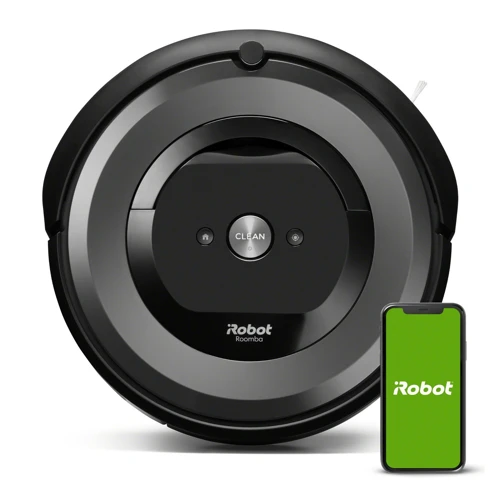
Pet owners with allergies are always on the lookout for ways to minimize allergens in their homes. Smart vacuum cleaners can be incredibly helpful in achieving an allergen-free environment. Here are some of the ways in which smart vacuum cleaners can help:
1. HEPA Filters
HEPA filters or high-efficiency particulate air filters, can capture tiny particles that a standard vacuum cleaner would miss. These filters trap allergens such as pet hair, pet dander, and dust mites effectively. While choosing a smart vacuum cleaner, look for the ones with HEPA filters as they can remove allergens from the air, leaving the home cleaner and healthier.
2. Suction Power
Smart vacuum cleaners usually have more powerful suction than traditional vacuum cleaners. They are designed to pick up more dirt, dust, and pet hair, and particularly thicker pet hair. Powerful suction ensures deep cleaning, leaving your home cleaner and free of allergens.
3. Automated Cleaning
Smart vacuum cleaners offer automated cleaning that can help pet owners with allergies clean their homes effectively. The self-charging, scheduling, and automatic docking features offered by smart vacuums make cleaning effortless. Once set up, users can ensure their homes are cleaned regularly, without having to be at home to do it.
In addition to the above, smart vacuum cleaners offer several other benefits such as app control, voice control, and smart sensors which can detect dirty areas of your home and clean them effectively.
If you’re looking to purchase a pet vacuum, keep in mind that not all vacuums are created equal. It’s important to choose the best one that suits your needs. For example, Shark and Dyson are two popular brands of pet vacuums. You can explore the differences between the two brands in this Shark vs Dyson pet vacuum review.
Pet owners with allergies can benefit significantly from using smart vacuum cleaners. With advanced features such as HEPA filters, powerful suction, and automated cleaning, a smart vacuum cleaner can help reduce allergens in the home and promote cleaner air.
1. HEPA Filters
One of the most crucial factors to consider when buying a smart vacuum cleaner for pet owners with allergies is the presence of HEPA filters. For those who are not familiar with HEPA filters, these are specialized filters that help trap microscopic allergens, including pet dander and pollen, that can trigger allergic reactions. So, if you want to keep your home free of allergens, investing in a smart vacuum cleaner with high-performing HEPA filters can be a game-changer. But why is it so important to choose a vacuum cleaner with HEPA filters? Let’s explore in more detail.
2. Suction Power
When it comes to cleaning up pet hair, dander, and other allergens, suction power is one of the most important factors to consider in a smart vacuum cleaner. The stronger the suction, the more effective the vacuum will be in removing these particles and other debris from your floors and carpets.
So, what should you look for in terms of suction power in a smart vacuum cleaner?
1. High Pa Rating: Pa is the measurement of suction power, so look for a high Pa rating when shopping for a smart vacuum cleaner. Models with a Pa rating of 15,000 or higher provide strong suction power that can pick up even the tiniest particles from your floors and carpets.
2. Multiple Suction Modes: Some smart vacuum cleaners come with multiple suction modes, such as eco, standard, and max modes. Make sure to choose a vacuum that has multiple modes, so you can adjust the suction power based on the type of mess you’re trying to clean up.
3. Dual Brushroll: A smart vacuum cleaner with a dual brushroll can help to agitate and lift debris from both carpets and hard floors, making it easier to suction up allergens and other particles.
4. Anti-Tangle Technology: If you have pets, you know how easily pet hair can get tangled in brushrolls, which can negatively impact the suction power. Look for a model with anti-tangle technology to prevent this issue.
Choosing a smart vacuum cleaner with strong suction power is essential for pet owners with allergies who want to keep their homes clean and allergen-free. Make sure to consider the Pa rating, suction modes, dual brushroll, and anti-tangle technology when making your selection.
3. Automated Cleaning
Automated cleaning is one of the key benefits of smart vacuum cleaners for pet owners with allergies. With this technology, the vacuum cleaner can move around your home, cleaning up pet hair, dander, and other allergens without any manual effort from you. This means that you can maintain a clean and allergen-free home without putting in any extra effort.
One of the most important things to look for in a smart vacuum cleaner with automated cleaning is the ability to map your home. This means that the vacuum cleaner can scan and remember the layout of your home, which will allow it to clean every room efficiently and without missing any spots.
Here are some additional benefits of automated cleaning:
- Convenience: You can set up the vacuum cleaner to clean on a schedule that works for you. This means that you can have it clean while you’re away from home or even while you’re sleeping.
- Saves Time: Because the vacuum cleaner is cleaning your home automatically, you don’t need to spend time pushing it around and cleaning each room yourself.
- Efficiency: Automated cleaning uses advanced sensors that detect obstacles and navigate around furniture, walls, and other objects with ease.
Smart vacuum cleaners with automated cleaning are an excellent investment for pet owners with allergies who want to maintain a clean home without putting in a lot of manual effort. These high-tech devices can save you time and help you breathe easier by removing pet allergens from the air.
What Features to Look for in a Smart Vacuum Cleaner?
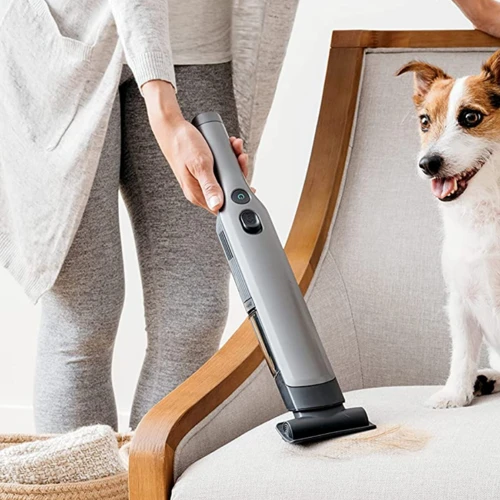
When it comes to choosing a smart vacuum cleaner for pet owners with allergies, there are a few key features to look out for. These features will not only make the cleaning process more effective but also more convenient as well.
1. Smart Sensors: Look for a vacuum cleaner that comes equipped with smart sensors. These sensors will help the vacuum to navigate around your home with ease, detecting obstacles and adjusting the cleaning path accordingly. This can be particularly helpful if you have pets who like to move around the house frequently.
2. Voice Control: Another useful feature to look out for is voice control. This allows you to control the vacuum using voice commands, which can be particularly handy if you are busy with other tasks or have mobility issues.
3. App Control: Many modern smart vacuum cleaners now come equipped with apps that can be downloaded onto your phone or tablet. This will allow you to control the vacuum remotely, set up cleaning schedules, and receive alerts when the vacuum needs maintenance.
4. HEPA Filters: While HEPA filters were already discussed in the previous section, it’s worth emphasizing again how important these are if you’re a pet owner with allergies. Look for a vacuum that includes a high-quality HEPA filter that can capture even the smallest particles of pet dander, dust, and pollen.
5. Suction Power: Pet hair and dander can be stubborn to lift from carpets and floors. Choosing a vacuum cleaner with powerful suction capabilities is essential for deep cleaning. The higher the suction power, the more effectively your vacuum cleaner will pick up dirt and allergens.
When you’re shopping for a smart vacuum cleaner to help you manage pet hair and allergies, it’s essential to consider these top features. Smart sensors, voice control, and the availability of an app can make cleaning up a breeze, while HEPA filters and powerful suction ensure that pet hair, dander, and pollen are captured effectively. Keep these features in mind when you’re searching for a vacuum cleaner to help you manage allergies, and you’ll be one step closer to achieving a cleaner, healthier home.
1. Smart Sensors
When it comes to choosing a smart vacuum cleaner for pet owners with allergies, one of the most important features to consider is the presence of smart sensors. These sensors allow the vacuum cleaner to navigate around obstacles and avoid falling down stairs, making cleaning effortless and hassle-free. But what exactly are smart sensors, and how do they work? Let’s explore this feature in more detail.
2. Voice Control
Voice control is another must-have feature to consider when choosing a smart vacuum cleaner. With this feature, you can control your vacuum using voice commands, rather than having to get up and manually adjust it. Not only is it more convenient, but it can also be a game-changer for those with mobility impairments.
Here are some benefits of having voice control on your smart vacuum cleaner:
- Hands-Free Cleaning: With voice control, you can clean your home without ever having to lift a finger. Simply speak your commands and let your vacuum do the work for you.
- Multi-Tasking: With voice control, you can multi-task while your vacuum is running. For example, you can cook dinner while your Roomba i7+ sweeps up pet hair and dander.
- Increased Efficiency: Voice control can be quicker and more efficient than manual control, as you don’t have to stop what you’re doing to make adjustments.
- Accessibility: For those with disabilities or mobility impairments, voice control can make cleaning your home easier and more accessible.
If you’re looking to automate your cleaning routine and make it as easy and efficient as possible, a vacuum cleaner with voice control is a great option. And with the rise of smart home technology, more and more vacuums are being equipped with this feature, making it easier than ever to find one with the specific functionalities you need.
3. App Control
Another important feature to look out for in a smart vacuum cleaner is the ability to control it via an app on your smartphone. With app control, you can easily start and stop cleaning sessions from anywhere, at any time. Additionally, app control allows you to customize and schedule cleaning sessions according to your specific needs.
But what are the benefits of having app control on your smart vacuum cleaner?
| Benefits of App Control | Explanation |
|---|---|
| Convenience | With app control, you can easily monitor and control your smart vacuum cleaner from anywhere, at any time. Whether you’re at work or on vacation, you can easily start and stop cleaning sessions and adjust settings as needed. |
| Customization | App control allows you to customize your cleaning sessions according to your specific needs. You can choose which rooms to clean, set specific cleaning times, and adjust the suction power and cleaning modes. |
| Automation | With app control, you can schedule cleaning sessions to run automatically at specific times. This means you can enjoy a consistently clean home without having to manually start the robot each time. |
| Real-time Notifications | App control can also provide real-time notifications about the status of your smart vacuum cleaner. You’ll be alerted when it’s time to empty the dustbin, when the battery is low, or when there’s an issue with the machine. |
Having app control on your smart vacuum cleaner is a convenient and efficient way to keep your home clean and allergen-free. With the ability to customize and schedule cleaning sessions from your smartphone, you’ll have more time to focus on the things that matter most.
Top Smart Vacuum Cleaners for Pet Owners with Allergies
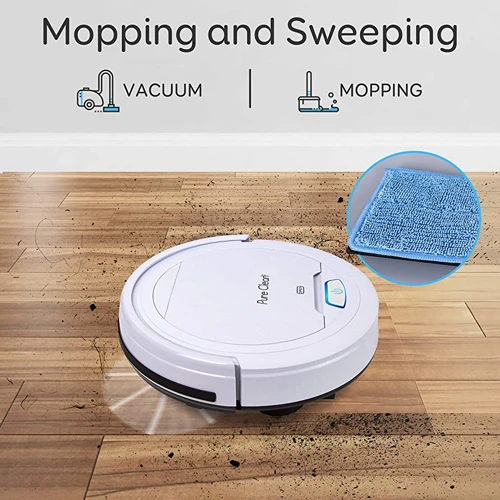
When it comes to keeping your home free of pet allergens, having a smart vacuum cleaner can make all the difference. But with so many options available on the market, it can be daunting to choose one. To help you narrow down your choices, we have researched and selected the top smart vacuum cleaners for pet owners with allergies.
1. Roomba i7+
The Roomba i7+ is a top-of-the-line robot vacuum cleaner that is equipped with a powerful suction system and a HEPA filter that captures 99% of pet allergens. What sets the Roomba i7+ apart from other robot vacuums is its Clean Base Automatic Dirt Disposal system, which allows the vacuum to empty itself after each cleaning session. It also has smart mapping technology, which enables it to learn and adapt to your home’s layout for more efficient cleaning.
2. Shark IQ Robot Self-Empty XL
Another excellent option for pet owners with allergies is the Shark IQ Robot Self-Empty XL. It also comes with a HEPA filter that traps microscopic pet allergens and a self-emptying dustbin. Its powerful suction system can easily pick up pet hair and dander from carpets and hard floors. Additionally, the Shark IQ Robot has smart home connectivity, enabling you to control it with voice commands or via a mobile app.
3. Roborock S6 MaxV Robot Vacuum
The Roborock S6 MaxV is a premium robot vacuum that is specifically designed for pet owners with allergies. It features a dual-camera system that can detect and avoid obstacles and pet waste, such as urine and feces. Its suction system is powerful enough to pick up even the finest pet hair and dander. It also has a long battery life, allowing it to clean continuously for up to 180 minutes.
These three smart vacuum cleaners are the best options for pet owners with allergies. They all feature powerful suction systems, HEPA filters, and self-emptying dustbins. What sets them apart are their additional features, such as smart mapping, obstacle detection, and voice control.
1. Roomba i7+
Pet owners with allergies often struggle to keep their homes free from pet hair, dander, and other allergens. Fortunately, smart vacuum cleaners have emerged as an effective solution to this problem. Among the top smart vacuum cleaners for pet owners with allergies is the Roomba i7+. This powerful device’s suction power and HEPA filters make it an ideal choice for cleaning pet hair and dander. However, what sets the Roomba i7+ apart from other smart vacuum cleaners is its ability to empty itself, making cleaning even more hands-off. Let’s take a closer look at what makes the Roomba i7+ an excellent option for pet owners with allergies.
2. Shark IQ Robot Self-Empty XL
The Shark IQ Robot Self-Empty XL is a top-performing smart vacuum cleaner for pet owners with allergies. It has many features that make it stand out from other robot vacuums on the market. Let’s take a closer look at what makes the Shark IQ Robot Self-Empty XL a great choice for pet owners with allergies:
| Feature | Description |
| Self-Emptying Dustbin | The Shark IQ Robot Self-Empty XL has a self-emptying dustbin which can hold up to 30 days of dust, debris and pet hair. This means you won’t have to empty the dustbin as often, which is a great time-saver. |
| HEPA Filtration | The Shark IQ Robot Self-Empty XL comes with a high-performance HEPA filter which traps 99.9% of dust, pollen, and pet dander. This is a great feature for pet owners with allergies as it ensures that the air in your home is free from allergens. |
| Multi-Surface Cleaning | The Shark IQ Robot Self-Empty XL has powerful suction and is designed to clean all surfaces including hardwood floors, carpets, and rugs. It has an advanced brush roll which is perfect for picking up pet hair, and its multi-surface brushes adjust to the height of each floor type, providing a deep clean. |
| Smart Navigation | The Shark IQ Robot Self-Empty XL has an advanced navigation system which maps your home and creates an efficient cleaning path. This ensures that every inch of your home is cleaned thoroughly, and it also means that the vacuum won’t get stuck or fall down stairs. |
| Voice and App Control | The Shark IQ Robot Self-Empty XL can be controlled via the SharkClean app on your smartphone, as well as through voice commands with Amazon Alexa or Google Assistant. This means you can start cleaning your home with the touch of a button or use your voice to control it. |
The Shark IQ Robot Self-Empty XL is a smart vacuum cleaner that excels in cleaning pet hair and dander from your home, while also providing great features for convenience and ease of use. Its self-emptying dustbin, HEPA filtration, multi-surface cleaning, smart navigation and voice and app control make it a great investment for pet owners with allergies who want to keep their homes allergen-free.
3. Roborock S6 MaxV Robot Vacuum
The Roborock S6 MaxV Robot Vacuum is one of the top smart vacuum cleaners for pet owners with allergies. This vacuum cleaner combines powerful suction with advanced features to help keep your home clean and allergen-free.
Suction Power: The Roborock S6 MaxV has 2500Pa of suction power, making it one of the most powerful robot vacuum cleaners on the market. With this high suction power, it can easily pick up pet hair, dust, and other allergens from your floors.
Obstacle Recognition: One of the most impressive features of the Roborock S6 MaxV is its obstacle recognition capability. It uses a stereoscopic camera to detect and avoid obstacles in its path, making it less likely to get stuck or tangled on cords and other objects.
Mapping and Navigation: The Roborock S6 MaxV comes equipped with advanced mapping and navigation features that allow it to efficiently navigate around your home. It uses both laser navigation and advanced mapping to create a detailed map of your home, which it then uses to clean your floors in the most efficient manner possible.
Multi-Floor Mapping: Another great feature of the Roborock S6 MaxV is its ability to map and clean multiple floors of your home. This is great for pet owners who have pets on multiple floors or who want to keep their whole home clean and allergen-free.
App Control: The Roborock S6 MaxV can be controlled using its smartphone app, which allows you to schedule cleaning times, set cleaning preferences, and even control it with your voice using Alexa or Google Assistant.
Here is a table summarizing the features of the Roborock S6 MaxV Robot Vacuum:
| Feature | Description |
|---|---|
| Suction Power | 2500Pa |
| Obstacle Recognition | Stereoscopic camera technology |
| Mapping and Navigation | Laser navigation and advanced mapping |
| Multi-Floor Mapping | Ability to map and clean multiple floors |
| App Control | Control with smartphone app or voice control using Alexa or Google Assistant |
The Roborock S6 MaxV Robot Vacuum is a top choice for pet owners with allergies who want a powerful and efficient vacuum cleaner to keep their homes clean and allergen-free. With its advanced features, strong suction power, and app controls, it is a great investment for any pet owner looking to improve their home’s air quality.
Other Tips for Keeping Your Home Allergen-Free
In addition to using a smart vacuum cleaner, there are several other ways that pet owners with allergies can keep their homes allergen-free.
1. Regular Pet Grooming
One of the most effective ways to control pet allergens is to groom your pets regularly. Brushing your pet’s coat every day can help remove loose hair, dander, and other allergens. If possible, bathe your pets once a week using a mild pet shampoo. This can help remove even more allergens from their fur.
2. Wash Bedding Frequently
Your pet’s bedding can harbor allergens, so it’s important to wash it frequently. Use hot water and a mild detergent to kill dust mites, pet dander, and other allergens. If possible, choose bedding materials that are hypoallergenic and easy to wash.
3. Use Air Purifiers
Air purifiers can help remove pet allergens from the air in your home. Look for models with HEPA filters, which are designed to capture even small particles like pet dander and pollen. Place air purifiers in the rooms where you and your pets spend the most time, such as bedrooms and living rooms.
By implementing these simple tips in addition to using a smart vacuum cleaner with high-quality filters and suction power, you can greatly reduce the allergen levels in your home and breathe easier.
1. Regular Pet Grooming
As a pet owner with allergies, you understand the importance of keeping your home as allergen-free as possible. One of the most effective ways to reduce pet dander and hair in your home is through regular pet grooming. This not only helps keep your furry friend’s coat healthy and shiny, but it can also significantly improve the air quality in your home. In this section, we’ll explore the benefits of regular pet grooming and how it can work in conjunction with your smart vacuum cleaner to keep your home a haven from allergens.
2. Wash Bedding Frequently
For pet owners with allergies, it’s important to keep your bedding clean and free of pet dander and other allergens. Washing bedding frequently helps to remove any buildup that could lead to an allergic reaction.
Why is washing bedding important?
Over time, bedding can accumulate skin cells, pet hair, and dander, and other allergens. This can create an ideal environment for dust mites, which are a common trigger for allergies. Washing bedding frequently can help to remove these allergens and prevent dust mites from taking up residence in your mattress and pillows.
How often should you wash your bedding?
It’s recommended that you wash your bedding at least once a week. This can help to keep your sheets, blankets, and pillowcases free of allergens. If you have pets that sleep on your bed or you notice that your allergies are particularly severe, you may want to consider washing your bedding more frequently.
What is the best way to wash bedding?
When washing bedding, it’s important to use hot water, which can help to kill any dust mites or other allergens. You should also use a detergent that is specifically designed for washing bedding, as these detergents are formulated to remove allergens effectively. Additionally, you may want to consider adding vinegar or baking soda to the wash cycle, as these natural remedies can help to remove any lingering odors.
To summarize, washing bedding frequently is an essential part of keeping your home allergen-free. By washing your sheets, blankets, and pillowcases once a week, you can help to remove allergens and prevent dust mites from taking up residence in your bedding. Use hot water, allergen-reducing detergent, and natural remedies like vinegar or baking soda to ensure that your bedding is as clean and allergen-free as possible.
| Tips for washing bedding: |
|---|
| Use hot water to kill dust mites and other allergens |
| Wash bedding at least once a week |
| Use a detergent specifically designed for washing bedding |
| Add vinegar or baking soda to remove any lingering odors |
Keeping your bedding clean is just one of many steps you can take to reduce allergens in your home. In the next section, we’ll explore other tips and tricks for keeping your home allergen-free.
3. Use Air Purifiers
Air purifiers are another essential tool in the war against pet allergens. These devices work by filtering out harmful particles like pet dander and hair from the air in your home. They come in all shapes and sizes, from small desktop models to larger units designed for whole-house use. When choosing an air purifier, look for models with HEPA filters, which are designed to capture tiny particles up to 0.3 microns in size. This includes pet dander, dust, pollen, and even some viruses.
Here is a comparison table of the top air purifiers for pet owners with allergies:
| Brand & Model | Room Coverage | HEPA Filter | CADR Rating | Noise Level |
|---|---|---|---|---|
| Winix 5500-2 | 360 sq. ft. | Yes | 232 | 28 dB |
| Honeywell HPA300 | 465 sq. ft. | Yes | 300 | 45 dB |
| Rabbit Air MinusA2 | 700 sq. ft. | Yes | 200 | 25.6 dB |
| Austin Air HealthMate Plus | 1,500 sq. ft. | Yes | 400 | 50-66 dB |
The CADR rating is an important consideration when choosing an air purifier. CADR stands for Clean Air Delivery Rate, which measures the amount of clean air a purifier can deliver in a given time. A higher CADR rating means the purifier is more effective at removing pollutants from the air. The noise level is also a consideration, especially if you plan to use the purifier in a bedroom or other quiet area.
Remember, air purifiers are not a cure-all for pet allergies. They can help reduce the amount of pet dander and hair in the air, but they do not eliminate the allergens entirely. In combination with smart vacuum cleaners and other pet grooming and cleaning practices, air purifiers can be part of a comprehensive strategy for keeping your home allergen-free.
Conclusion
In conclusion, investing in a smart vacuum cleaner is one of the best things you can do for your home if you’re a pet owner with allergies. By choosing a smart vacuum cleaner with advanced features like HEPA filters, powerful suction, and automated cleaning, you can successfully tackle the challenges of pet hair, pet dander, and pet urine.
Additionally, it’s essential to look for a smart vacuum cleaner with smart sensors, voice control, and app control so that you can operate it easily and efficiently. The Roomba i7+, Shark IQ Robot Self-Empty XL, and Roborock S6 MaxV Robot Vacuum are all excellent options for pet owners with allergies.
However, relying solely on a smart vacuum cleaner isn’t enough to keep your home allergen-free. Remember to groom your pets regularly, wash their bedding frequently, and use air purifiers to complement the cleaning done by your smart vacuum cleaner.
Overall, with the right smart vacuum cleaner and a few additional steps, pet owners with allergies can breathe easy and enjoy a cleaner, healthier home. So don’t hesitate to invest today and experience the benefits of a smart vacuum cleaner for yourself!
Frequently Asked Questions
1. How do pet allergens affect people?
Pet allergens can cause a range of symptoms, from mild to severe, including sneezing, runny nose, itchy eyes, coughing, and even asthma attacks in some people.
2. Can pet hair alone cause allergies?
Pet hair itself is not an allergen, but it can trap and carry other allergens like pet dander, urine, and saliva, which can trigger an allergic reaction.
3. What is a HEPA filter and how does it work?
HEPA stands for High-Efficiency Particulate Air. A HEPA filter traps tiny particles like pet dander, pollen, and dust mites, preventing them from circulating in the air. It works by forcing air through a fine mesh that traps the particles.
4. Is a suction power important when choosing a vacuum cleaner for pet hair?
Yes, suction power is important as it determines how much dirt and pet hair the vacuum can pick up. The stronger the suction, the better it will be at removing pet hair and dirt from carpets and other surfaces.
5. Can smart vacuum cleaners be controlled with a mobile app?
Yes, most smart vacuum cleaners come with a mobile app that allows you to remotely control and schedule cleaning sessions, check the status of the machine, and adjust the cleaning settings.
6. What is the benefit of using voice control with a smart vacuum cleaner?
Voice control allows you to control your smart vacuum cleaner without having to physically interact with it. This can be useful for people with mobility issues or for those who want to control the vacuum while doing other activities.
7. How often should I groom my pet to reduce allergens?
Grooming your pet once a week can significantly reduce the amount of pet hair and dander in your home. Regular brushing, bathing, and trimming can also keep your pet’s coat healthy and shiny.
8. Is it necessary to change the filter in a vacuum cleaner frequently?
Yes, to ensure optimal performance, you should change the filter on your vacuum cleaner at least every 3 to 6 months, depending on the frequency of use and the type of filter.
9. Can air purifiers help with pet allergies?
Yes, air purifiers can help remove pet allergens from the air, reducing the likelihood of an allergic reaction. Look for air purifiers that use HEPA filters or have other specialized filters designed to target pet allergens.
10. How do I choose the right smart vacuum cleaner for my needs?
Consider factors such as suction power, filter quality, smart features, and price when choosing a smart vacuum cleaner. Read reviews and do some research to find a machine that fits your specific needs and budget.


